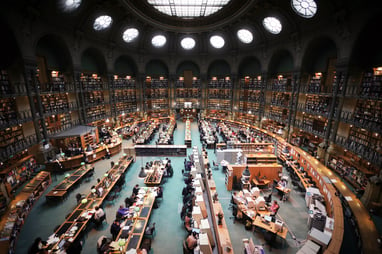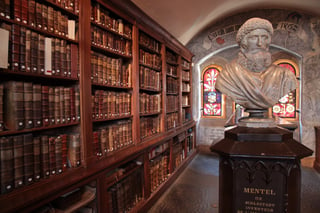Bibliothèque nationale de France
 The National Library of France, located in Paris, started out as Charles V's personal collection and was once housed in the Louvre. As Charles V expanded his collection, he made sure the works were meticulously cataloged and worked to have ancient texts translated into French. The collection was maintained by his son, Charles VI, but upon his death, the collection was sold to the English regent of France, the Duke of Bedford and was moved to England. While Charles VII could not recover the books, the invention of the printing press made it easier for him to begin a new collection in honor of his grandfather. Each subsequent monarch added to the collection, including a sizable increase in holdings upon the acquisition of Catherine de Medici's personal library.
The National Library of France, located in Paris, started out as Charles V's personal collection and was once housed in the Louvre. As Charles V expanded his collection, he made sure the works were meticulously cataloged and worked to have ancient texts translated into French. The collection was maintained by his son, Charles VI, but upon his death, the collection was sold to the English regent of France, the Duke of Bedford and was moved to England. While Charles VII could not recover the books, the invention of the printing press made it easier for him to begin a new collection in honor of his grandfather. Each subsequent monarch added to the collection, including a sizable increase in holdings upon the acquisition of Catherine de Medici's personal library.
In 1666, the library was moved to the Rue Vivienne. It opened to the public in 1692. After the French Revolution, the library grew to an impressive 300,000 books. Soon after, Napoleon took interest in the library, adding his own private collection and further increasing it with books acquired during his campaigns. In 1868, the library was moved to a new location in Rue de Richelieu and renamed the Imperial National Library.
In 1988, a new construction was proposed for the library. Planning itself took years, and the construction of the building was plagued with issues. The project went drastically over budget and faced numerous technological struggles. In 1996, construction of its current location was completed, though the Rue de Richelieu location is still in use to house certain collections. The mission of the library, in accordance to that of the Ministry of Culture, is to collect and house books published in France. In addition to its nearly fourteen million books, the library also houses coins, sheet music, maps, documents, letters, magazines, and digital collections, all available to the public. It is proudly open to anyone who has a need.
Bibliothèque de la Sorbonne
Sorbonne Library began as the College of Sorbonne's theology collection. The library was compiled by Jesuits in 1289, and when they left the university in the 1700s, they left the entire collection and buildings to the University of Paris. The library was disbanded during the French Revolution, and books were scattered between other libraries and private collectors. It was not until the revolution was over that the historical importance of the library was once again considered. New structures were built on the grounds of the no-longer-standing medieval buildings.
In 1793, the library acquired several major collections during the closing and opening of numerous different educational institutions. While many books were given to the National Library of France, Sorbonne managed to confiscate and purchase a number of important books from the House of Montmorency and the Princes of Conde.
In 1823, the library moved across the Rue Saint-Jacques where it remains today, in a building known as the "new Sorbonne." It merged with the University of Paris Library in 1930, but those collections were transferred in 1970. In 1972, it merged with the Library of Art and Archeology, though this only lasted for only six years.
The library began working on restoration in 2010 which was completed in 2013, creating new galleries and reading rooms to house more patrons than ever before. Currently, the library houses 2.5 million volumes, both in French and foreign languages. The library has an impressive Richelieu collection, and it is known for its impressive ancient history collections, as well as philosophy and religious sciences. The holdings are organized into five sections: Law, Medicine, Letters, Sciences, and Pharmacy. It boasts over 13,000 members.
The Humanist Library of Sélestat
 The Humanist Library of Sélestat in Alsace is one of the region's most treasured locations, featuring prominently in both its cultural preservation plans and its tourism endeavors. It is actually comprised of two libraries: The Library of the Humanist School and The Beatus Rhenanus Library. The Library of the Humanist School existed in its first form as the library of the Latin school in Alsace. In 1441, Ludwig Dringenberg was named master of the school. A humanist, Dringenberg instilled many of his ideals into the school and began to build up its library. His successors, also humanists, carried on his work, educating an entire generation of humanists and building up an impressive library with the aid of endowments from like-minded donors.
The Humanist Library of Sélestat in Alsace is one of the region's most treasured locations, featuring prominently in both its cultural preservation plans and its tourism endeavors. It is actually comprised of two libraries: The Library of the Humanist School and The Beatus Rhenanus Library. The Library of the Humanist School existed in its first form as the library of the Latin school in Alsace. In 1441, Ludwig Dringenberg was named master of the school. A humanist, Dringenberg instilled many of his ideals into the school and began to build up its library. His successors, also humanists, carried on his work, educating an entire generation of humanists and building up an impressive library with the aid of endowments from like-minded donors.
The other library, The Beatus Rhenanus Library, was given to the town at the time of his death. The collection was comprised entirely of rare and very limited production books, and at the time, it was considered both educationally and monetarily priceless. It is the largest Humanist library to remain in tact. While there were larger libraries of its kind, no collection is as complete as the one given to the town of Sélestat. In 1889, the libraries were combined under one roof.
Today, the library is open to the public only as a museum due to the delicate condition of the Renaissance documents. Scholars, however, may be granted access to the books. The library collection is comprised of an impressive two thousand incunabula, Renaissance era books, and prints, sculptures, and paintings.
Image sources:
-By Vincent Desjardins - Flickr: France, Paris : Bibliothèque nationale de France, site Richelieu, salle ovale 1897-1936, CC BY 2.0, retrieved here
-By Alexandre Dulaunoy from Les Bulles, Chiny, Belgium - La bibliothèque humaniste de Beatus Rhenanus / Humanist Library of Beatus Rhenanus, CC BY-SA 2.0, retrieved here








